Text
It's big, it's strong, its scaly, it's this week's Wet Beast Wednesday topic! An arapaima, also known as a pirarucu or paiche, is any of four species of fish in the genus Arapaima in the order of bony-tongued fish. There is som ongoing debate about the classification of the species, so to keep thing simple, I'm going to use the most common species names of Arapaima gigas (the type species and most well known, and the one with the most confusion about its classification), Arapaima agassizii, Arapaima leptosoma, and Arapaima mapae. Because A. gigas is the most well-studied of the species, unless I say otherwise you can assume everything I say in this post applies to it.

(image: an arapaima)
Arapaimas are bony fish that retain several primitive traits, causing them to sometimes be identified as "living fossils". They are most notable for their size, with A. gigas being a contender for the largest freshwater fish in the world. The maximum recorded size for one was 3.7 meters (10 ft) and 200 kg (400 lbs), but most get to around 2 meters (6.6 ft) long and 200 kg (440 lbs). That average length is decreasing as overfishing of the largest individuals is resulting in a selective pressure for smaller sizes. In addition to their size, they are extremely strong and can move fast if needed. Arapaima are fully capable of leaping out of the water if disturbed or they feel their current pond in unsuitable. Because of their strength, specimens in captivity must be handled with care as they can easy break bones if they slap someone. They live in rivers and lakes in South America, where they are often the top predators.
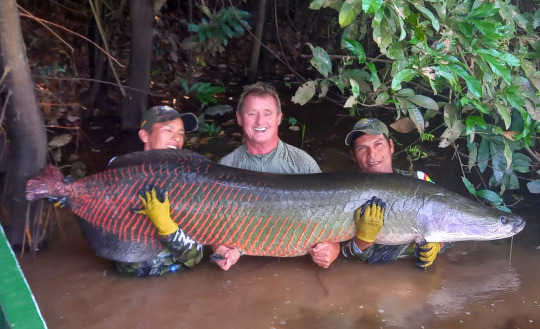
(image: several anglers with an arapaima)
Arapaimas are obligate air-breathers and will drown if they can't get to the surface to breathe. This is accomplished with a specialized swim bladder. The swim bladder is filled with highly vascularized tissue, letting it act like a lung. This pseudo-lung opens into the mouth using a modified gill arch known as the labyrinth organ. Arapaima gills are too small to sustain them, but they can supplement their oxygen intake with the gills. Juveniles are born exclusively using their gills and transition into air-breathers shortly after hatching. Arapaimas can survive up to a full day out of the water. They typically surface to gulp in air every 15-20 minutes. Breathing makes a loud gulping sound that anglers use to target them.
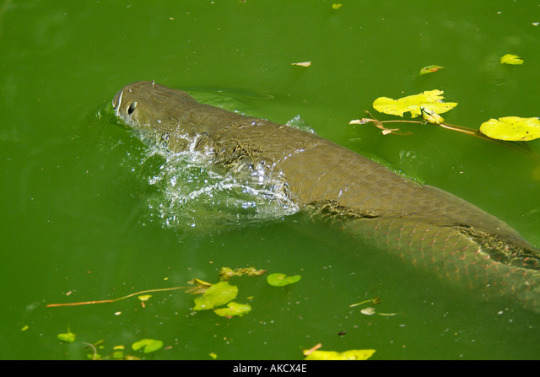
(image: an arapaima at the surface)
Because of their ability to breathe air, arapaimas are top predators in low-oxygen environments. Non-air breathing fish are forced to slow down in water with low levels of dissolved oxygen as they can't get enough oxygen through their gills. Since Arapaimas breathe air, they can easily chase down lethargic smaller fish. They are especially potent predators during the low season, when water levels lower. A combination of rotting vegetation reducing oxygen levels and ponds getting cut off from rivers and losing a supply of oxygen lets the arapaima reign supreme. Arapaimas are primarily predators that feed on smaller fish, though they will hunt other types of animals and eat fruits and seeds. Even land animals aren't safe as arapaimas have been known to launch themselves out of the water to catch animals near the shore. A combination of sharp teeth and their bony tongues are used to debilitate prey.
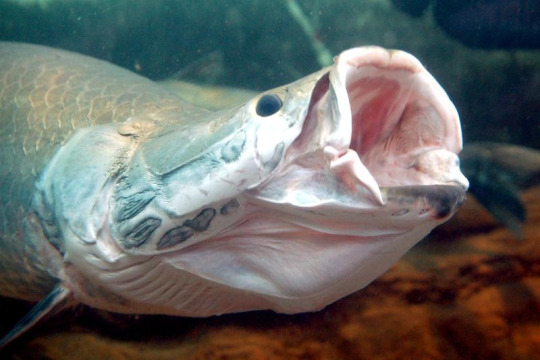
(image: an arapaima with its mouth open)
Not content with powerleveling their attack stat, arapaimas also have excellent defense. Their scales have been compared to bullet proof vests. Each has a hard, mineralized outer layer over multiple layers of collagen fibers. These layers are all oriented at an angle to each other to provide extra strength. This orientation of layers is called a Bouligand-type arrangement and is similar to how plywood is assembled. The harder outer layers and flexible inner layers work together to allow for both strength and flexibility. These scales help provide protection form large predators such as caiman and small threats like biting piranha. They also like provide protection from other arapaima, as the fish are aggressive and will fight each other.

(image: a diagram showing the composition of arapaima scales. source)
You probably wouldn't expect a swimming tank of an animal to be a good parent, but you'd be wrong. Arapaimas work together in mated pairs to build nests for their eggs, then cooperate to guard the nest. Once the eggs hatch, the male will practice mouth brooding, keeping his young safe in his mouth. The female will also help by patrolling the area around the male to ward off predators. They secrete pheromones from their heads to ensure the young don't swim too far away. Eggs are laid either in in the low season or as water levels are starting to rise, ensuring that the young become independent during the high season.
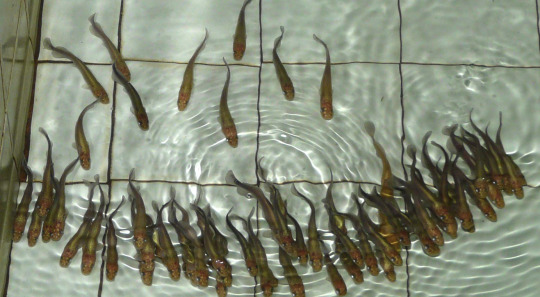
(Image: baby arapaimas)
Arapaima are classified as "data deficient" by the IUCN. This means there isn't enough data to properly assess their conservation needs. They are known to be threatened by overfishing. Arapaima make up a large part of the diet of many South American populations. Habitat loss and pollution are also believed to threaten them. They have been introduced to many areas out of their native range and are an invasive species in placed like Florida, Malaysia, and India.
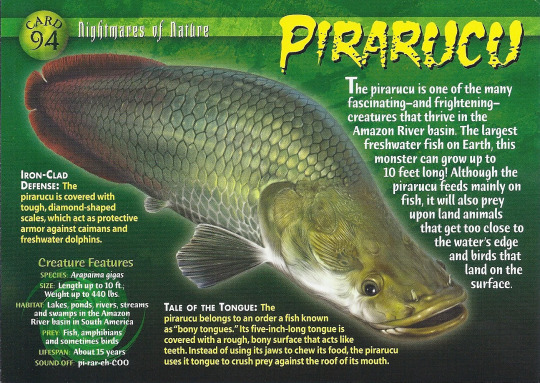
Does anyone else remember these cards? (image: the arapaima card from Weird n' Wild Creatures)
1K notes
·
View notes
Text
youtube
Meet the glass squids 🦑
Glass squids live in the boundless waters of the twilight zone. With no protective shell and nowhere to hide, they have to get creative.
Glass squids use an invisibility cloak to stay safe in these dark waters. Like other cephalopods, they are covered in tiny pigment sacs called chromatophores. When their chromatophores are closed, their skin is basically see-through.
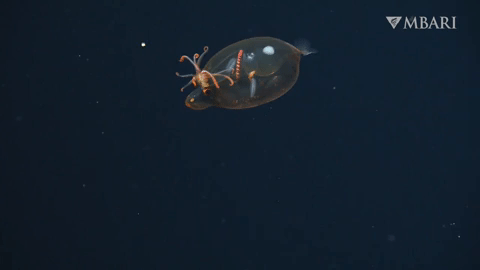
When their cover is blown, they expand their chromatophores to darken their appearance. Or they might simply ink and jet away!
Glass squids also have special light organs that mask the shadow of their more opaque body parts. This helps them maintain their cloak of invisibility and hide from both predators and prey.

But the future of all midwater animals is in jeopardy. The deep seafloor contains many precious minerals critical to modern technologies—like the batteries in your phone. Mining these metals will release plumes of wastewater that will cloud the ocean's twilight zone.
We urgently need to identify the impacts deep-sea mining will have across all ocean habitats, from the midwater to the seafloor.

Help protect the glass squid by sharing what you've learned. Together we can build a community of ocean champions!
Learn more about this and other fascinating animals of the deep on our website.
942 notes
·
View notes
Text
The Almaco Jack, also known as a longfin yellowtail, a silver coat jack or a highfin amberjack is a fish closely related to the Greater and lesser Amberjacks, reaching a midpoint in size between the two of them, with the biggest recorded Almaco being just over 130 lbs. or just under 60 kg. with most specimens being seen at anywhere from 5-25 pounds, rarely exceeding those sizes except in rare conditions, similar to Amberjacks. These species, while common in and around the gulf of Mexico and Atlantic ocean, can also be caught in the Pacific ocean, with both the largest recorded specimen of GAJ's and AlJ's being recorded along the Japanese coast. These fish are a fun, hard fight from an angling standpoint, with most anglers slow pitch jigging or bottom fishing to catch or hook these beautiful fish. Commonly found in deeper coastal waters, with larger schools congregating around wrecks or reefs. The Almaco Jack can be distinguished from the GAJ by the tall dorsal fin, and the shorter, less torpedo shaped body. On the other fin, GAJ's are known for being so hard to target because they are very hydrodynamic, with low fins and minimum shape changes, along with being a favorite target of sharks such as bull sharks or blacktip sharks.
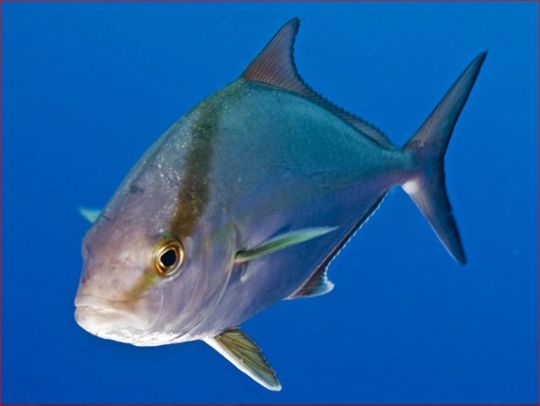
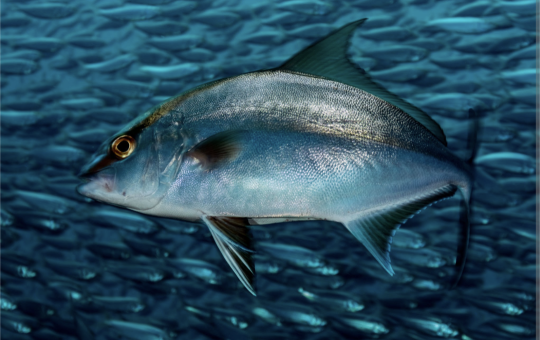
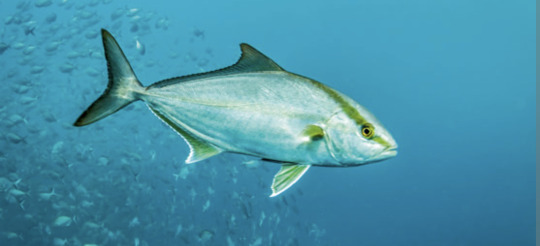
Above are all Almaco Jacks.
Below are all Greater AmberJacks


Amberjacks typically have a broader stripe that starts after the eye, whereas Almacojacks have a stripe that is on both sides of the eye.
It's not even funny how hard it is to find pictures of GAJs without old white men holding them.
3 notes
·
View notes